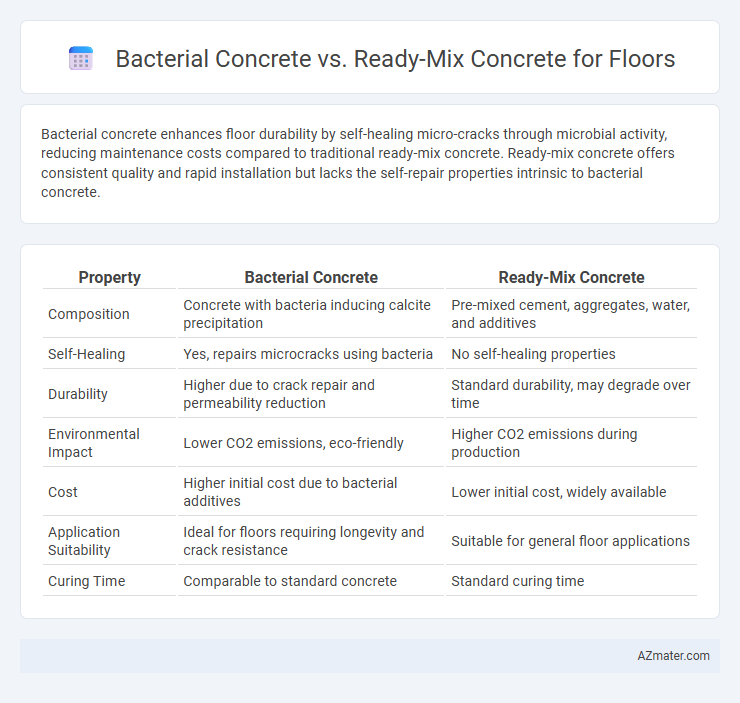Bacterial concrete enhances floor durability by self-healing micro-cracks through microbial activity, reducing maintenance costs compared to traditional ready-mix concrete. Ready-mix concrete offers consistent quality and rapid installation but lacks the self-repair properties intrinsic to bacterial concrete.
Table of Comparison
| Property | Bacterial Concrete | Ready-Mix Concrete |
|---|---|---|
| Composition | Concrete with bacteria inducing calcite precipitation | Pre-mixed cement, aggregates, water, and additives |
| Self-Healing | Yes, repairs microcracks using bacteria | No self-healing properties |
| Durability | Higher due to crack repair and permeability reduction | Standard durability, may degrade over time |
| Environmental Impact | Lower CO2 emissions, eco-friendly | Higher CO2 emissions during production |
| Cost | Higher initial cost due to bacterial additives | Lower initial cost, widely available |
| Application Suitability | Ideal for floors requiring longevity and crack resistance | Suitable for general floor applications |
| Curing Time | Comparable to standard concrete | Standard curing time |
Overview of Bacterial Concrete and Ready-Mix Concrete
Bacterial concrete incorporates specific bacteria that induce calcium carbonate precipitation to self-heal cracks, enhancing durability and reducing maintenance costs. Ready-mix concrete is pre-mixed at a batching plant according to precise specifications, ensuring consistent quality and rapid application for large-scale flooring projects. The choice between bacterial and ready-mix concrete depends on factors like structural requirements, environmental conditions, and desired longevity of the floor.
Composition and Working Principles
Bacterial concrete incorporates specific microbial strains that promote calcium carbonate precipitation, enhancing self-healing and durability, while ready-mix concrete consists of a pre-mixed blend of cement, aggregates, water, and admixtures designed for immediate use and uniform strength. The working principle of bacterial concrete relies on bacteria-induced mineralization to fill micro-cracks, whereas ready-mix concrete hardens through hydration reactions between cement and water, providing a consistent structural matrix. Compositionally, bacterial concrete integrates bio-ingredients like Bacillus subtilis spores and calcium lactate, contrasting with the purely inorganic mix of ready-mix concrete.
Strength and Durability Comparison
Bacterial concrete exhibits enhanced strength and durability compared to ready-mix concrete by utilizing microbial-induced calcite precipitation, which reduces micro-cracks and improves self-healing properties. Its compressive strength can be up to 20-30% higher than traditional ready-mix concrete, resulting in longer service life and increased resistance to environmental degradation. Ready-mix concrete, while widely used for floors due to its consistent quality and ease of application, often requires additional chemical additives to achieve comparable durability.
Crack Resistance and Self-Healing Capabilities
Bacterial concrete exhibits superior crack resistance and self-healing capabilities compared to ready-mix concrete due to the presence of calcite-producing bacteria that seal micro-cracks autonomously, enhancing durability. Ready-mix concrete, although consistent in quality and time-efficient, lacks intrinsic self-healing properties, making it more susceptible to crack propagation under stress. The integration of microbial-induced calcite precipitation in bacterial concrete significantly extends floor lifespan by reducing maintenance frequency and improving structural integrity.
Environmental Impact and Sustainability
Bacterial concrete enhances environmental sustainability by promoting self-healing properties that reduce repair frequency and material waste compared to ready-mix concrete. The bacterial carbonation process sequesters CO2, lowering the overall carbon footprint, while ready-mix concrete production typically involves higher CO2 emissions due to cement manufacturing and transportation. Using bacterial concrete for floors extends durability and minimizes resource consumption, supporting more eco-friendly construction practices aligned with green building standards.
Cost Factors and Economic Viability
Bacterial concrete reduces long-term maintenance costs due to its self-healing properties, lowering repair frequency and extending floor lifespan compared to ready-mix concrete. Ready-mix concrete offers lower initial costs and faster installation, making it economically viable for projects with tight budgets and shorter timelines. Investment in bacterial concrete becomes cost-effective in high-durability applications where lifecycle cost savings outweigh the higher upfront material expenses.
Installation and Application Methods
Bacterial concrete involves integrating specific bacterial spores and nutrients into the concrete mix, which requires careful handling and precise dosing during installation to ensure effective self-healing properties. Ready-mix concrete is pre-prepared in batching plants and transported to the site, allowing for faster placement with standardized consistency, making it suitable for large-scale flooring applications. Installation of bacterial concrete demands specialized knowledge for mixing and curing, while ready-mix concrete can be applied using conventional methods such as pumping or pouring, followed by standard finishing techniques.
Maintenance and Longevity
Bacterial concrete enhances floor durability by self-healing microcracks, significantly reducing maintenance frequency compared to ready-mix concrete. Its bio-mineralization process seals cracks autonomously, extending longevity beyond 50 years in optimal conditions. Ready-mix concrete floors typically require periodic repairs and resurfacing within 20-30 years due to their susceptibility to cracking and wear.
Suitability for Residential and Commercial Floors
Bacterial concrete enhances durability and self-healing properties, making it highly suitable for long-lasting residential floors exposed to minor cracks and moisture damage. Ready-mix concrete offers consistent quality and quick installation, ideal for commercial floors requiring uniform strength and faster project completion. Both types meet structural demands, but bacterial concrete excels in sustainability and maintenance cost reduction for residential applications.
Future Prospects and Industry Trends
Bacterial concrete incorporates microbial-induced calcite precipitation, offering self-healing properties and enhanced durability, making it a promising alternative for sustainable flooring solutions in future construction projects. Ready-mix concrete remains dominant due to its standardized quality, ease of use, and scalability, with increasing innovations focusing on eco-friendly additives and improved workability to meet growing industry demands. The trend towards green building practices and smart infrastructure supports the gradual adoption of bacterial concrete, while ready-mix concrete continues to evolve with technological advancements to optimize performance and reduce environmental impact.

Infographic: Bacterial concrete vs Ready-mix concrete for Floor
 azmater.com
azmater.com